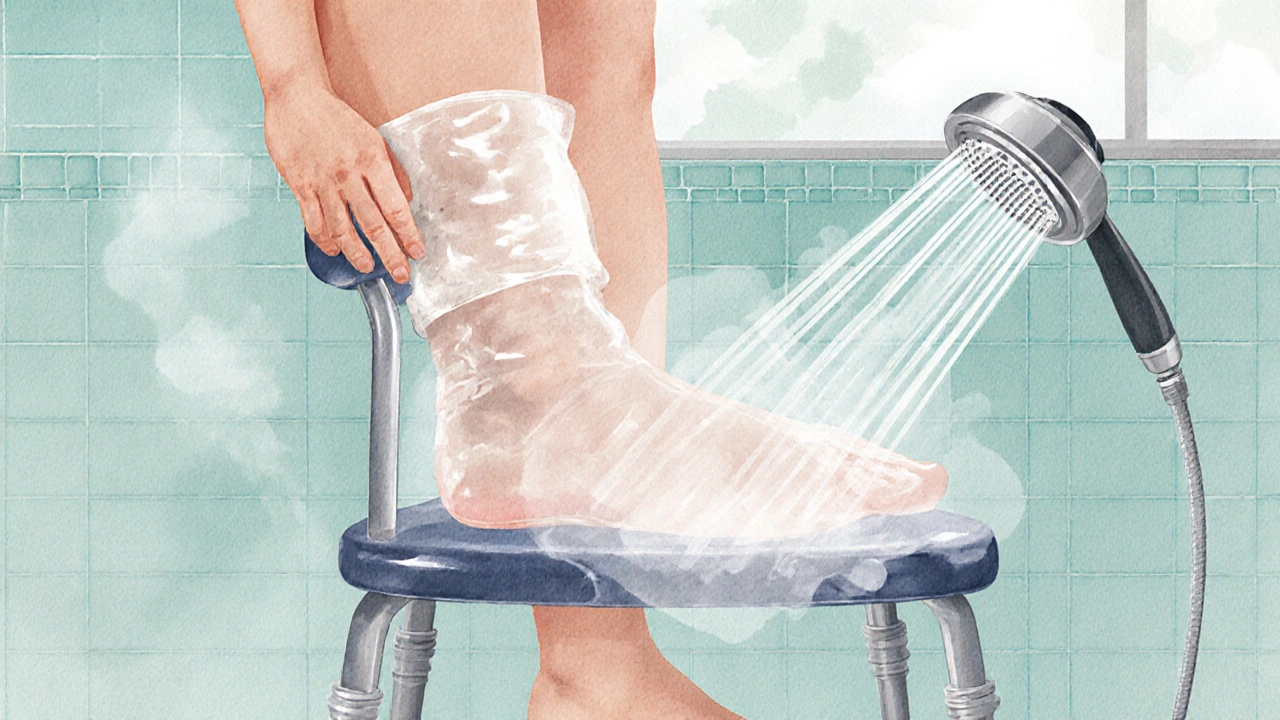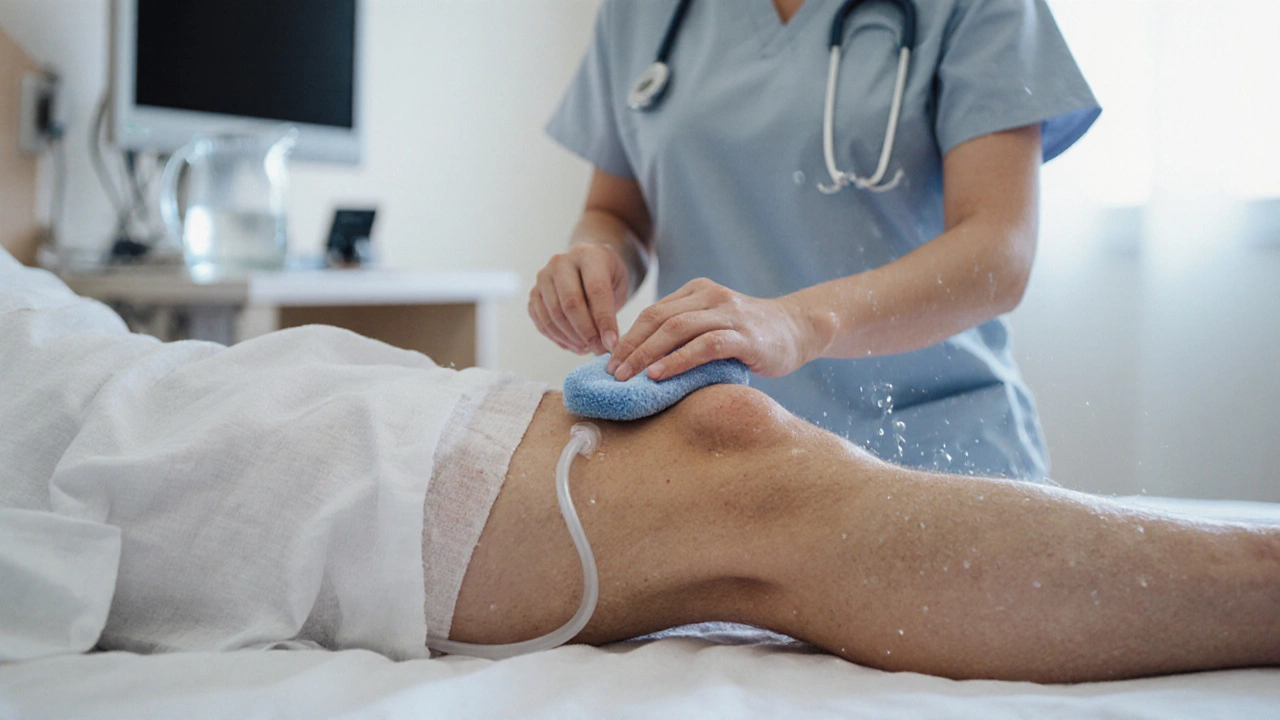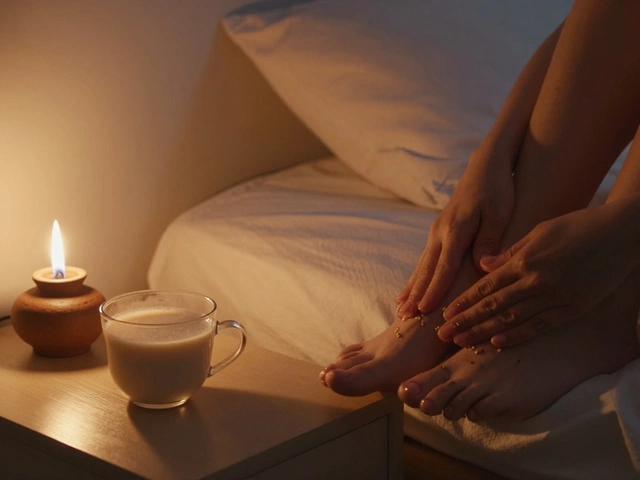Knee Replacement Shower Safety Calculator
Calculate Your Safe Shower Timeline
Answer these key questions to get personalized guidance based on your surgical details.
Your Safe Shower Timeline
Key Recommendations:
Wondering when you can finally hop into the shower after a knee replacement? It’s a common question because a clean, comfortable shower feels like a small win in the middle of a long recovery. The good news is that most surgeons let you get wet fairly early-usually within a day or two-if you follow a few simple rules. Below we break down the factors that influence shower timing, walk through a step‑by‑step timeline, and give you practical tips to keep the incision dry while staying safe.
Understanding the Surgery and the Healing Process
Knee replacement surgery is a procedure that replaces damaged knee joint surfaces with artificial implants to restore function and relieve pain. The operation involves cutting through skin, muscle, and bone, then stitching the incision closed. Right after the cut, the body starts a cascade of healing: blood clots form, tissues rebuild, and the new joint settles into place.
Two things matter most for a safe shower:
- Incision integrity-the stitches or staples must stay dry until they’re strong enough to hold on their own.
- Drainage management-some patients leave a small tube to collect excess fluid. That tube needs to stay protected from water.
Both of these are part of Post‑operative care, the set of instructions your surgeon gives you to prevent infection and promote healing.
Key Factors That Influence When You Can Shower
Every patient is unique, but the following factors generally decide how soon you can get wet:
- Type of dressing: Traditional gauze dressings need to stay dry for 24‑48 hours, while waterproof dressings can be removed or left on for a longer period.
- Presence of a drainage tube: If a tube is still in place, many surgeons ask you to keep it covered for 24 hours.
- Overall health: Conditions like diabetes or a compromised immune system may delay showering to reduce infection risk.
- Hospital protocol: Some facilities have a set timeline-usually 24 hours after surgery-before they allow a patient to shower.
- Personal comfort: If you feel sore or dizzy, it’s better to wait until you’re steadier on your feet.
Typical Timeline: From Surgery Day to First Shower
Here’s a day‑by‑day look at what most patients experience. Adjustments may be needed based on the factors above.
- Day 0 (Surgery day): You’ll be in the recovery room, usually unable to move much. The incision is covered with a sterile dressing, and you’ll likely have a drainage tube.
- Day 1 (24 hours post‑op): Nurses may remove the drainage tube if output is low. Your surgeon or physical therapist will check the incision. If it looks clean and the stitches are holding, they may give the green light for a brief sponge‑bath or a carefully supervised shower.
- Day 2-3: Most patients take a full shower. Use a waterproof dressing if you have one, or replace the gauze with a clean, dry one after the first shower. A Shower chair can help you stay seated and avoid slipping.
- Day 4-7: Continue with daily showers, but monitor the incision for any redness, swelling, or drainage. Replace dressings according to your surgeon’s schedule, usually every 2‑3 days.
- Week 2 and beyond: Most dressings are gone, and you can shower normally. Focus now shifts to Physical therapy and gentle range‑of‑motion exercises.
How to Shower Safely: Practical Tips
Even when your doctor says it’s okay, a few habits can keep you from turning a simple shower into a setback.
- Test water temperature with your hand before stepping in; lukewarm water is best.
- Use a handheld showerhead so you can control the flow and avoid spray directly on the incision.
- Keep the incision covered with a waterproof dressing or a plastic wrap secured with medical tape.
- Stay seated on a non‑slip shower chair, especially during the first few showers.
- Pat dry gently with a clean, soft towel-don’t rub.
- Apply prescribed ointment right after drying, if your surgeon recommended it.
Following these steps lets you stay clean without risking a wet bandage.
Shower Options Comparison
| Option | Pros | Cons | Typical Use Period |
|---|---|---|---|
| Standard gauze dressing + sponge‑bath | Low cost, easy to replace | Limited mobility, can get soaked unintentionally | First 24‑48 hrs |
| Waterproof dressing (e.g., Tegaderm) | Allows full shower, protects incision | May cause skin irritation if left too long | Day 2 onward (until dressing change) |
| Shower chair + open‑air exposure | Reduces fall risk, easy to reach incision | Requires chair purchase or rental | Throughout recovery, especially first week |
| Bath tub soak (rarely advised) | Comfortable for some patients | High infection risk, water pressure can stress stitches | Generally avoided |

Common Concerns and How to Address Them
Patients often worry about a few specific scenarios. Here’s quick guidance:
- “What if my dressing gets wet?” - If a gauze dressing becomes damp, change it immediately with sterile supplies. A wet dressing can harbor bacteria.
- “Can I use soap on the incision?” - Mild, fragrance‑free soap is safe once the dressing is removed. Avoid scrubbing directly on the stitch line.
- “I feel dizzy after standing up in the shower.” - This is common due to anesthesia leftovers. Sit on the chair, take a break, and have a family member assist if needed.
- “Is it okay to use a hair dryer near the incision?” - A low‑heat setting held at least 6 inches away is fine for drying the area, but it’s not necessary if you pat gently.
When to Call Your Surgeon
Even with careful showering, keep an eye out for warning signs. Contact your orthopedic team immediately if you notice:
- Increasing redness, swelling, or warmth around the incision.
- Fluid that looks yellow, cloudy, or has a foul odor.
- Fever above 100.4 °F (38 °C) that doesn’t go away.
- Severe pain that worsens after a shower.
Early intervention can prevent a minor infection from becoming a serious problem.
Quick Checklist Before Your First Shower
- ✅ Doctor has cleared you for showering.
- ✅ Drainage tube (if any) is removed or properly covered.
- ✅ Waterproof dressing or clean dry dressing is in place.
- ✅ Non‑slip shower chair and handheld showerhead are ready.
- ✅ Warm (not hot) water temperature set.
- ✅ Towel, clean soap, and any prescribed ointment nearby.
- ✅ Someone is nearby to help if you feel faint.
Crossing off these items gives you confidence that you’re doing everything right.
Bottom Line: You Can Shower Sooner Than You Think
Most knee replacement patients can take a safe, comfortable shower after knee replacement within the first 24‑48 hours, provided they follow the surgeon’s instructions and use proper protection. The key is to keep the incision dry, stay stable, and watch for any signs of infection. With the right mindset and a few handy tools, a quick rinse can become a welcome boost to morale during the early weeks of recovery.
How long after knee replacement can I have a full shower?
Most surgeons allow a full shower 24 to 48 hours after surgery if the incision is closed, the drainage tube (if used) is removed, and a waterproof dressing is applied. Always confirm with your own surgeon.
Do I need a special dressing for showering?
A waterproof dressing such as Tegaderm or Opsite is ideal because it lets you shower without worrying about moisture seeping to the stitches. If you use gauze, keep the shower brief and protect the area with a plastic cover.
Can I use a regular bathtub?
Generally, a bathtub soak is discouraged during the first weeks because water pressure can strain the incision. If you must bathe, use a shallow foot‑only soak and keep the knee as dry as possible.
What if the dressing becomes wet?
Replace it right away with a fresh sterile dressing. A wet dressing can become a breeding ground for bacteria, increasing infection risk.
Is it okay to shave hair around the incision before showering?
Avoid shaving until the incision is fully healed. Shaving can irritate the skin and introduce microbes. Let the surgeon or physical therapist give the green light first.
How can I stay steady while showering?
Use a non‑slip shower chair, place a rubber mat on the floor, and keep a sturdy grab bar within reach. Have a family member nearby for extra support.










